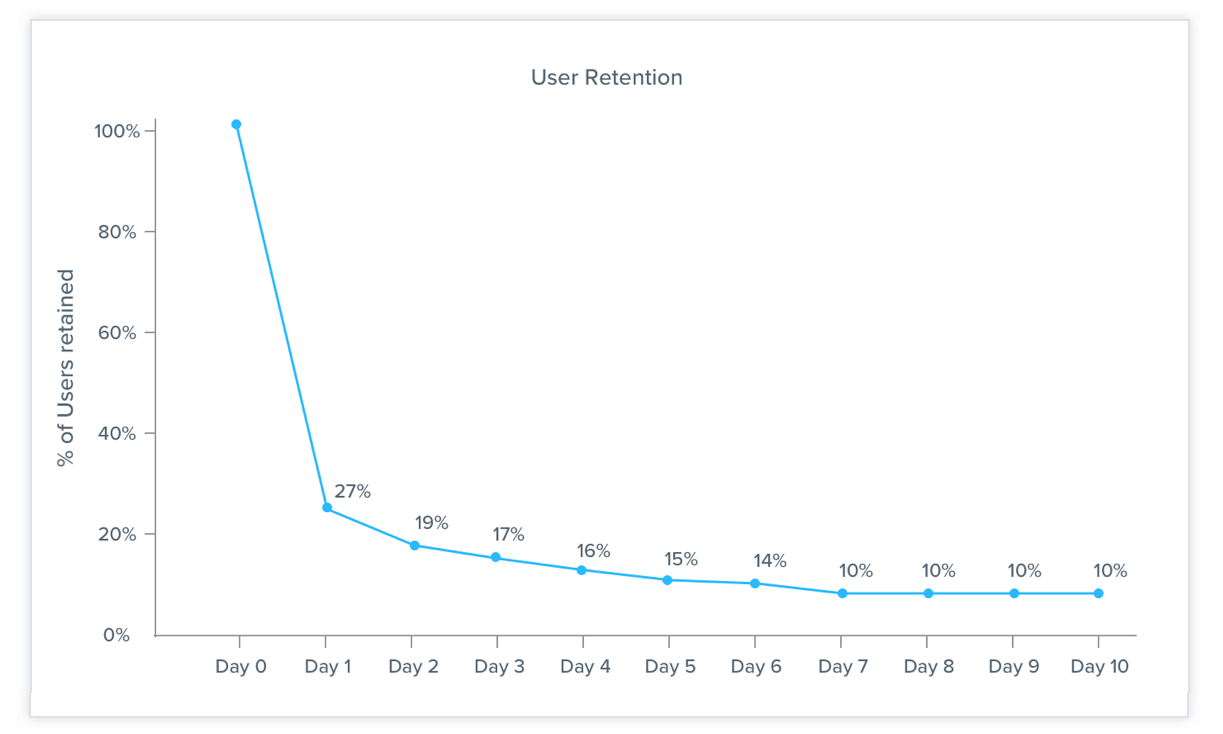Back to blog
5 MIN READ
6 Ways to Boost In-App Engagement Metrics for 2025
PUBLISHED
10 November, 2024


In-app engagement metrics are the gold standard of the tech world.
They are a befitting reflection of the touch points that customers have with products and apps. So much so that in an ideal ecosystem, they often end up dictating the direction of technological development.
As Steve Jobs says, “You’ve got to start with the customer experience and work back toward the technology, not the other way around.”
And when it comes to the world of apps, such a perspective cannot be closer to the truth. These jaw-dropping app engagement statistics paint a compelling picture:
Users spend 85% of their time engaging with only 5 non-native apps of the App Store.
Only 12% of active smartphone users look for new apps every day.
46% of smartphone users are now using voice to engage with apps.
Moreover, here is what the average retention curve of apps looks like:


All of this and more only reiterates the importance of customer engagement metrics for app adoption today.
How to increase in-app engagement metrics
Let’s look at some of the leading ways in which in-app user engagement metrics can be boosted:
Create a Focused Onboarding Program
If users do not understand the value proposition of an app, they will not use it. This is what makes ‘onboarding’ a crucial ingredient in the mix. Being the very first step of the process, onboarding also carries the onus of casting a memorable first impression.
By highlighting the key features and benefits, both retention rates and Lifetime Value (LFV) of new users can be significantly boosted.
If users do not understand the value proposition of an app, they will not use it. This is what makes ‘onboarding’ a crucial ingredient in the mix. Being the very first step of the process, onboarding also carries the onus of casting a memorable first impression.
By highlighting the key features and benefits, both retention rates and Lifetime Value (LFV) of new users can be significantly boosted.
Some of the best onboarding practices include:
Emphasizing the value proposition of the app from an ideal point-of-view. “Here’s what our app can do” and “Here is what you can do with our app” may sound familiar at first, but they are poles apart.
Highlighting core app features, functionalities, and buttons. For instance, compatibility with word documents is a primary feature (and strength) of Google Docs. Hence, Google aptly includes it in the onboarding process.
Just asking for permissions that are mandatorily needed for proper app functioning.
Making the signup process as easy as possible and ending with a relevant CTA.
Provide Real-Time Support for Better Engagement Metrics
One of the easiest ways to boost user engagement metrics is to become proactive, especially in customer support. Most app engagement trends today point towards one key variable – instant gratification. With the proliferation of technology and on-demand services/features, impatience is rife at the user’s end.
This is why leading market players are working hard to extend products like co-browsing, chatbot and live chat tool. As a result, users are able to:
Extend their chat experience beyond text and solve customer care issues in real-time.
Engage with customers at precise instances in their purchase journey and maximize the chances of conversions.
Address support queries with auto/canned messages to handle customer support at scale.
Implement custom and branded engagement sections in apps that add relevant context to chats.
Help support teams to gather relevant data about customers that can be later leveraged by sales teams.
And much more!
Personalize Offers and In-App Push Notifications
Push notifications give marketers a strategic edge when it comes to reminding users about the app. But it is also important to strike the right chord in terms of quantity.
While a number of notifications can fail to engage, too many of them can put them off. This is the reason why more than 50% of the app users consider push notifications to be annoying.
Thus, it becomes imperative to construct and deliver push notifications in a non-intrusive manner. Their performance can then be mapped via metrics such as conversion, click rate, and user engagement. And naturally, notifications that take into account the profiles and user behaviors tend to perform much better than the broadcast type.
Primary push notification strategies include:
Getting users to opt-in to push notifications by using engagement elements such as splash screens.
Using personalized notifications to reach up to the 800% engagement level of generic notifications.
Prompting users with limited time offers on the basis of the target and objectives.
Urging users to update their apps so that they do not miss out on new features or
improvements.
Motivating User-Generated Content
As evident, user-generated content (UGC) refers to the type of content that is created by the users of applications. Not only do they boost engagement metrics, but they also lead to increased word-of-mouth marketing. Leading types of user-generated content for apps can include reviews, mentions in forums, images, links, and more.
One can explore the following benefits:
Imparts of the crucial element of authenticity to applications as users tend to trust other users more than the word of companies.
Forges a relationship between the brand and the users, increasing the level of trust.
Personalizes the experience for all users, enabling them to have a unique voice.
Motivates users to use the app over and over again, significantly boosting engagement metrics.
Triggering Automated Behavioral Emails
User engagement can also take place outside of the product. Based on prior engagement patterns with users, automated emails can be triggered. This can intervene at relevant points in the user journey, making it more likely for users to take action.
Events that can (and should) be used to trigger emails can be:
Activation/Sign-up Emails: Welcome emails are an engaging way to introduce the brand and add a personal touch to the onboarding process.
One-off Emails: Emails can also be set to be triggered as a response to specific events, such as certain users not using the app for X days.
Educational Drip Emails: Upskilling users about features of products and their benefits over a period of time.
Customer Feedback Surveys: Collecting feedback from customers by sending them short surveys.
Track the Right App Engagement Metrics
The best app engagement strategy is incomplete without tracking the right in app engagement metrics. No matter how exceptional you app engagement ideas could be, you cannot improve a metric that you do track properly.
Choosing the right engagement metrics will help you identify usage patterns and trends, discover friction points and roadblocks in the app user journey. While are different engagement-related metrics to consider during an app engagement analysis, here are some of the top user engagement metric you should pay attention to:
Daily Active users
Monthly active users
Session Length
Session Interval
Screen Views and Engagement Flow
Churn rate
Events
Social Interaction
Conclusion
User engagement is more important than attracting a mass of customers who end up being dormant. These practices will help you explore app engagement strategies in the short run while also doubling up as customer retention strategies in the long run.
Ready to measure, analyze, and increase your app engagement metrics?
Create a free UXCam Account here — with 100,000 free monthly sessions and unlimited
Related Articles
The Hotjar for mobile apps: UXCam
10 mobile app engagement metrics to track and measure
AUTHOR

Sam Makad
Sam Makad is an experienced writer and marketing consultant. His expertise lies on marketing and advertising. He helps small & medium enterprises to grow their business and overall ROI.
What’s UXCam?
Related articles
App Analytics
Mobile App Tracking: Practical Guide & Best Tools [2026]
The best tracking tools for mobile...

Jonas Kurzweg
Product Analytics Expert
App Analytics
Top Analytics SDKs 2026
Pick the right analytics SDKs to improve your app's...

Jonas Kurzweg
Product Analytics Expert
Product best practices
8 Best UX Analytics Tools and Software We’ve Tested 2025
A good UX design is key when it comes to user satisfaction. Learn about five of the best UX analytics tools you can use to get valuable insights about user...

Jonas Kurzweg
Product Analytics Expert


